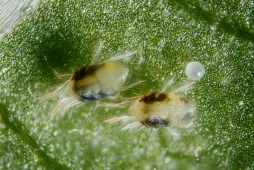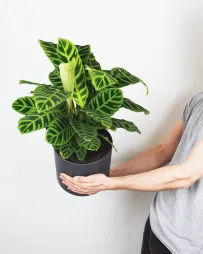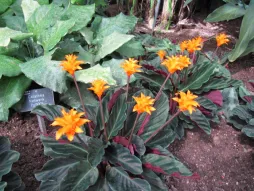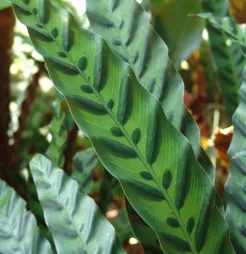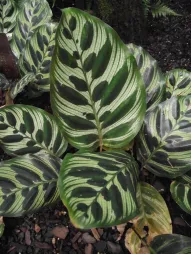Goeppertia ornata, a sleeper with remarkable foliage
Like many of its cousins in the Marantaceae family, Goeppertia ornata grows in the primeval forests of South America. In our temperate climates, this perennial is grown indoors, notably for its decorative foliage worthy of the finest paintings.
How to recognize Goeppertia ornata?
A rhizomatous plant with a bushy habit, Goeppertia ornata doesn't exceed 60 centimetres in height or width.
Like goeppertia lancifolia and goeppertia zebrina, its leaves are purple on the underside. The upper surface is shiny green, with striations on either side of the veins. Each line resembles a hand-drawn brushstroke. Pink when still young, the stripes turn white as the plant grows.
The conditions under which Goeppertia ornata is grown indoors make flowering rare. In the first spring, you may see white or yellow flowers appear in their cylindrical bracts.
Calathea has retained a strange habit from its wild life. Every evening, it folds its leaves to protect them from nocturnal parasites. With a little attention, you can observe this delicate movement and even hear your plant moving. But don't panic! In the morning, it'll be back in full view of the curious!
Our maintenance tips
Not very demanding, your Goeppertia ornata is content with a location without direct sunlight and plenty of humidity.
Watering
Goeppertia ornata fear excess water. To prevent root rot, allow the substrate to dry between waterings and remove any stagnant water from the saucer.
Water the soil preferably with rainwater. The soil should be moist but not soggy.
Spray
If the air in your home is dry, spray the leaves of your plant with non-calcareous water at room temperature.
Repotting
In spring, transfer your Goeppertia ornata to a larger pot, so that it can continue to grow.
Choose a pierced pot one-third larger than the previous one. Choose width rather than height to allow roots to develop. Choose a plastic or ceramic container rather than a clay one. The latter tend to absorb water more quickly.
Install a bed of clay balls and cover it with potting soil for indoor plants. Don't hesitate to mix in some perlite to optimize drainage. Then place the rootball and add potting soil until you reach a centimetre or two below the rim of the pot. Tamp down to avoid air bubbles.
Fertilization
You can stimulate the development of your plant during its growth phase, in spring and summer, with fertilizer.
Apply liquid green plant fertilizer diluted with water.
Cleaning
The dust that accumulates on the leaves of your Goeppertia ornata slows down the photosynthesis process. To enable it to thrive, dust regularly and gently.
To remove dust, wipe both sides of the leaf with a soft, slightly damp cloth. Support the larger ones with your other hand to prevent damage.
If your plant looks dirty, you can add some black soap to the water to moisten your cloth.
To remove dust, wipe both sides of the leaf with a soft, slightly damp cloth. Support the larger ones with your other hand to prevent damage.
If your plant looks dirty, you can add some black soap to the water to moisten your cloth.
Prune
Remove dead leaves and wilted flowers.
Cutting
Cutting is carried out during the strong growth phase, generally in spring and early summer.
Carefully dig up the plant. Observe its root system and locate the individual plants. Separate them, always keeping a stem with its leaves and roots.
Division can be done by hand. But if the roots are too tangled, you can cut them with a clean, sharp tool.
Get a pot with holes to suit the size of your seedlings. Line the bottom with clay balls or gravel to improve drainage.
Pour in a rich, light substrate, such as potting soil, and plant your cuttings. To help you, you can use a pencil to form a pilot hole.
Water to encourage rooting and eliminate air bubbles.
Diseases / Threats
Information
| Family | Marantaceae - Marantaceae |
| Type | Goeppertia - Goeppertia |
| Species | Goeppertia ornata - Goeppertia ornata |
| Lifecycle | Perennial |
| Foliage | Evergreen |
| Exposures | |
| Substrat | |
| Planting method |
In pots |
| Categories | |
| Tag |
Soiffarde |
| Origin |
South America |
| Hardiness (USDA) | 12a |
| Leaf color |
|
| Flower colors |
|
Discover plants from the same family












